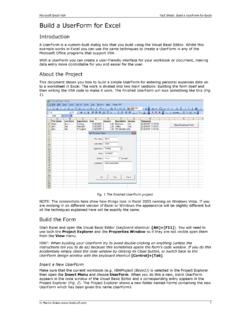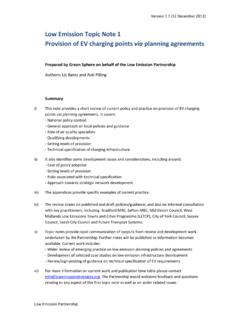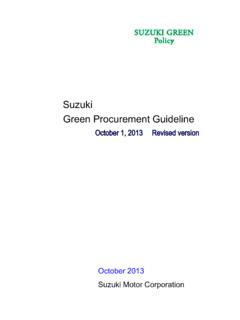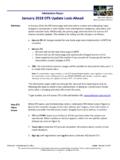Transcription of Build a UserForm for Excel - Martin Green's Office …
1 Microsoft Excel VBA Fact Sheet: Build a UserForm for Excel Martin green 1 Build a UserForm for Excel Introduction A UserForm is a custom-built dialog box that you Build using the Visual Basic Editor. Whilst this example works in Excel you can use the same techniques to create a UserForm in any of the Microsoft Office programs that support VBA. With a UserForm you can create a user-friendly interface for your workbook or document, making data entry more controllable for you and easier for the user. About the Project This document shows you how to Build a simple UserForm for entering personal expenses data on to a worksheet in Excel . The work is divided into two main sections: building the form itself and then writing the VBA code to make it work. The finished UserForm will look something like this (Fig. 1). Fig. 1 The finished UserForm project. NOTE: The screenshots here show how things look in Excel 2003 running on Windows Vista.
2 If you are working in an different version of Excel or Windows the appearance will be slightly different but all the techniques explained here will be exactly the same. Build the Form Start Excel and open the Visual Basic Editor (keyboard shortcut: [Alt]+[F11]). You will need to use both the Project Explorer and the Properties Window so if they are not visible open them from the View menu. HINT: When building your UserForm try to avoid double-clicking on anything (unless the instructions tell you to do so) because this sometimes opens the form's code window. If you do this accidentally simply close the code window by clicking its Close button, or switch back to the UserForm design window with the keyboard shortcut [Control]+[Tab]. Insert a New UserForm Make sure that the current workbook ( VBAP roject (Book1)) is selected in the Project Explorer then open the Insert Menu and choose UserForm .
3 When you do this a new, blank UserForm appears in the code window of the Visual Basic Editor and a corresponding entry appears in the Project Explorer (Fig. 2). The Project Explorer shows a new folder named Forms containing the new UserForm which has been given the name UserForm1. Microsoft Excel VBA Fact Sheet: Build a UserForm for Excel Martin green 2 You should also see the Toolbox (Fig. 3). If it is not visible click anywhere on the new UserForm (the Visual Basic Editor hides the toolbox when it thinks you are working elsewhere) and if it still does not appear open it from the View menu. Fig. 2 The Project Explorer shows the UserForm . Fig. 3 The Toolbox The UserForm has a dotted border around it. On the border, in the lower-right corner and halfway along the bottom and right sides of the form, are small white squares. These are the resizing handles. You can use the mouse to drag these handles to make the UserForm the required size.
4 The grid of dots on the form is to help you easily align items you place there. Rename the UserForm and Add a Caption A single project can include many UserForms so it is a good idea to give each one a meaningful name. With the UserForm selected find the Name property in the Properties Window (it is normally the first item in the list) and change it frmExpenses. Then change the Caption property to Staff Expenses Claim. The Project Explorer now displays the UserForm 's new name and the Title Bar of the form immediately changes to show the new caption (Fig. 4). Fig. 4 The form's Title Bar shows the new caption. When naming forms and their controls remember that you must not include spaces in the name, or use any of the VBA "reserved words" ( those keywords that are part of the VBA language such as "Date"). Add a TextBox Control and a Label The controls are the items, such as textboxes, comboboxes and command buttons, that will be placed on the form.
5 The standard selection of controls is represented by buttons on the Toolbox. Point at a Toolbox button to see a tooltip showing the name of the control. Add a TextBox control to the form by clicking on the TextBox button in the Toolbox then clicking somewhere near the centre of the form. As with the UserForm itself any control that you place on the form shows a dotted border and resizing handles when the item is selected (click on any item to select it). You can change the size and shape of a control either by dragging the resizing handles (the mouse pointer will change to a double-headed arrow (Fig. 5)) or by changing the values of its Height and Width properties in the Properties Window. To move a control drag the dotted border at a point between resizing handles (the mouse pointer will show a four-headed arrow (Fig. 6)) or change the values of its Top and Left properties.
6 Fig. 5 Resizing a control. Fig. 6 Moving a control. Drag the textbox to a point near the top of the UserForm and about halfway across the form. Microsoft Excel VBA Fact Sheet: Build a UserForm for Excel Martin green 3 Each control should have a meaningful name so that when you write the code you can easily identify it. This one currently has the name TextBox1. Use the Properties Window to change its name to txtFirstName. HINT: It is helpful when naming controls to add a prefix describing the type of control ("txt" for textbox, "cbo" for combobox etc.). This reminds you what type of control it is when you are working in the code. It forces the names to appear together when displayed in a list. It also lets you use words that are otherwise reserved ( txtDate instead of Date). Now use the toolbox to place a Label control on the form. To change the caption of the label you can either type directly on to the label or you can change its Caption property in the Properties Window.
7 Change the label's caption to First Name:. Change the TextAlign property of the label to 3-fmTextAlignRight then double-click the lower-right corner resizing handle to snap the label to fit the text (Fig. 7). Drag the label to a position just to the left of the FirstName textbox. Fig. 7 Double-click the lower-right corner handle to snap the label to size. When you move controls around by dragging them they snap to points on the grid. Whilst this is a useful feature, sometimes you need to position objects more accurately. You will notice that you can not place the label exactly level with the centre of the textbox. The grid forces it to be too high or too low. Use the Properties Window to subtract (or add as necessary) 3 units from the Top property of the label so that it is correctly positioned in relation to the textbox (Fig. 8). Fig. 8 Use the Properties Window to finely adjust the position of a control.
8 It isn't necessary to give the label a different name because, in this project, you will not be referring to it in the code, although in other circumstances you might want to do so. Add the Remaining Controls Use the same techniques to add the remaining controls to the form. You need to add four textboxes, a combobox (a textbox with a drop-down list), a checkbox and three command buttons. Here is a list of the remaining controls you need to add and their properties: Name: txtLastName Caption: Last Name: Name: cboDepartment Caption: Department: Name: txtDate Caption: Date: Name: txtAmount Caption: Amount: Name: chkReceipt, Caption: Receipt? Name: txtDescription, Height: 45, Width: 132, Scrollbars: 2-fmScrollbarsVertical Caption: Description: Name: cmdOK, Caption: OK Name: cmdClear, Caption: Clear Name: cmdCancel, Caption: Cancel HINT: At any time you can check out exactly how the UserForm will look in use by pressing the [F5] key on your keyboard or clicking the Run button on the Visual Basic Editor toolbar.
9 Doing this will open the UserForm in its host program (in this case Excel ). To return to the Visual Basic Editor, close the UserForm by clicking the close button [x] in its upper-right corner. Microsoft Excel VBA Fact Sheet: Build a UserForm for Excel Martin green 4 The finished UserForm should look something like this (Fig. 9): Fig. 9 The finished UserForm in design view (left) and in use (right). Create the ComboBox List The Department combobox now needs to be told where to get the information to Build its list. There are two ways to do this. It can be done with code (this method is described in the next section) or it can refer to a named range of cells in the workbook. The latter method is often preferred because you can easily edit the list without having to rewrite any code. Switch to Excel and open a worksheet in the same workbook. Type a column of items representing the entries you want to appear in the combobox list.
10 Put one item in each cell. If you want the items to appear in alphabetical order sort the list in the worksheet. Now select the cells containing the list items and name the range of cells. The easiest way is to click in the Name box (the box just above and to the left of cell A1), type the name Departments (Fig. 10) then press [Enter]. Click somewhere else on the worksheet then check that you have correctly named the range by clicking the down-facing arrow to the right of the Name box. You should see your range name in the list. Choose it and check that Excel selects the cells that contain your list. Fig. 10 Name a range of cells containing the list. Fig. 11 The combobox displays the list. If you add items to the list at a later date you may need to redefine the list. You can do this by opening Excel 's Insert menu and choosing Name then Define. Return to the Visual Basic Editor and click on the Department combobox to select it then go to the Properties Window and find the RowSource property.







